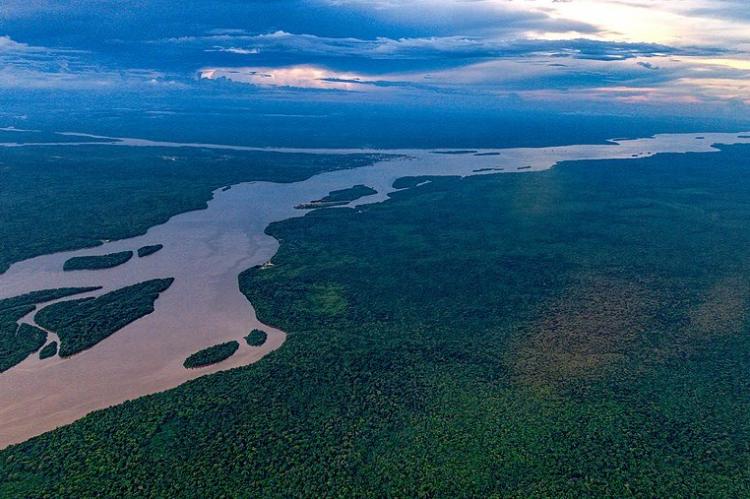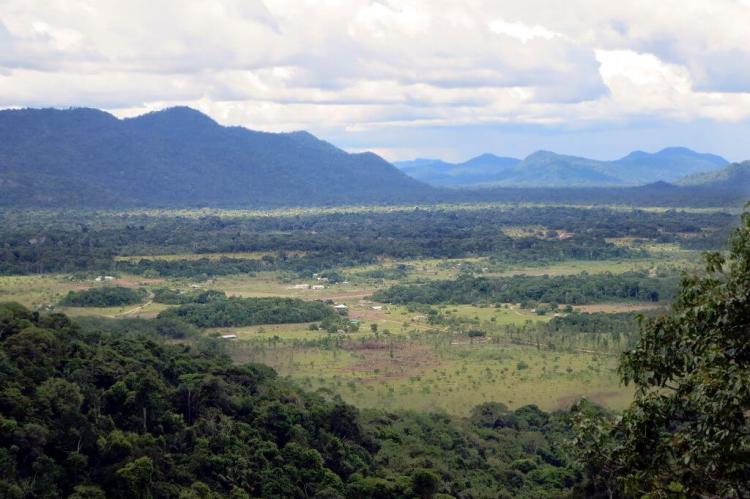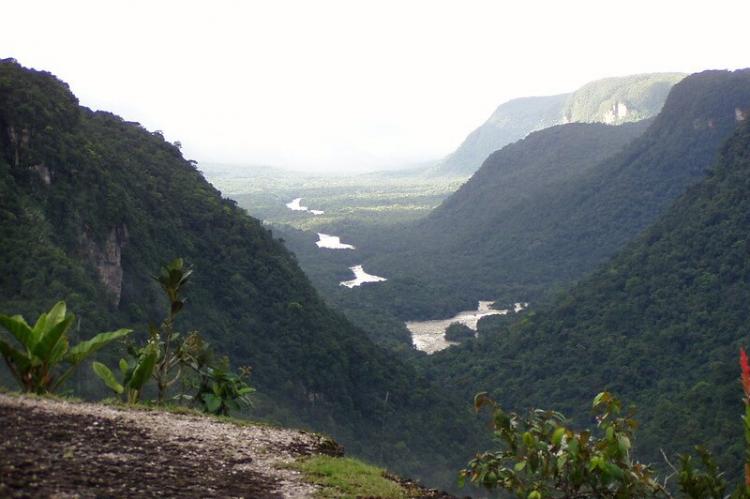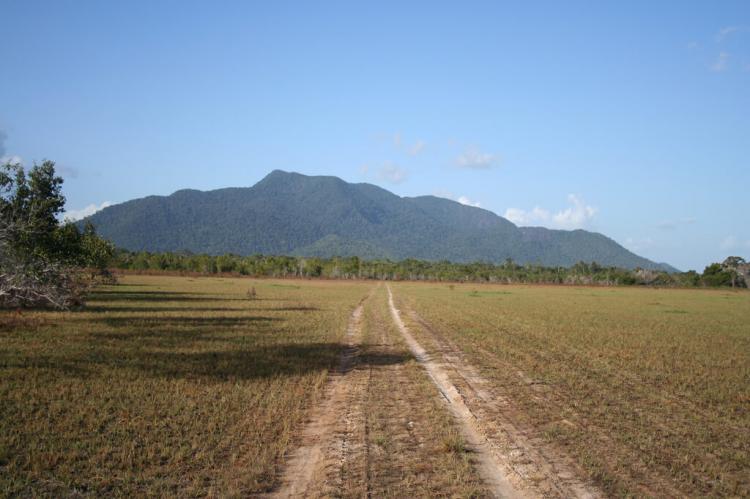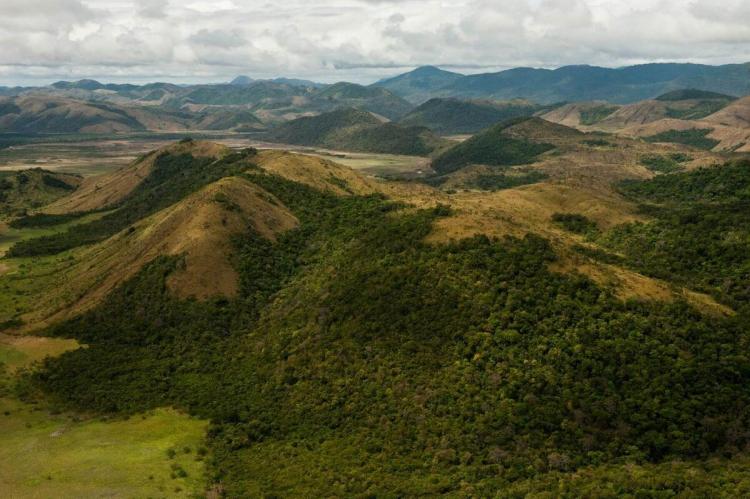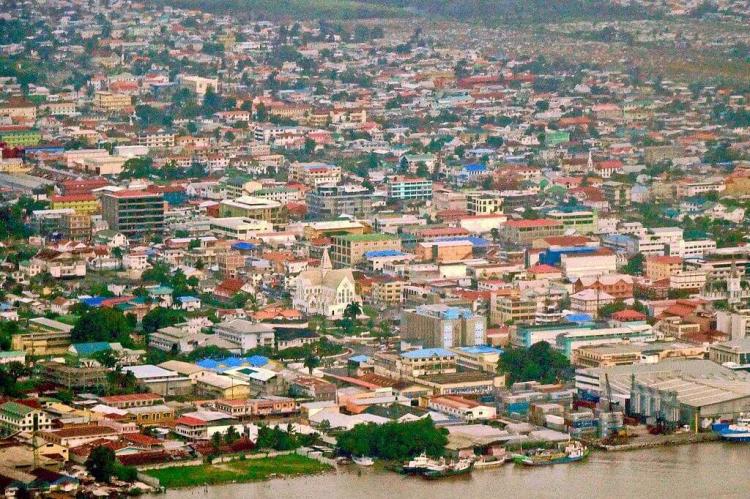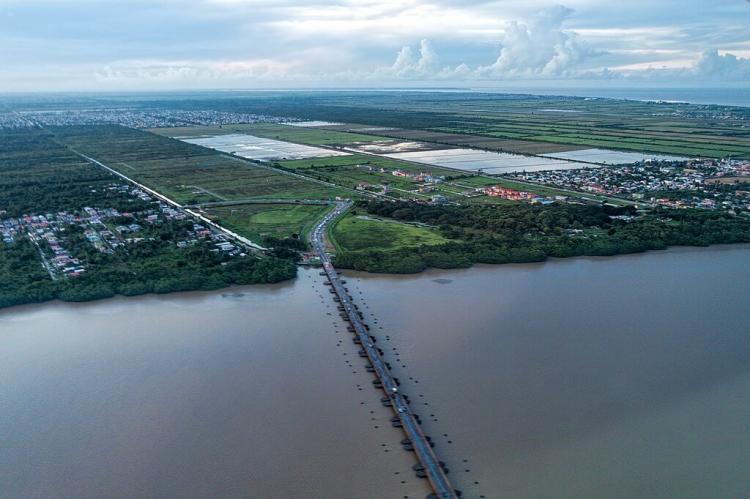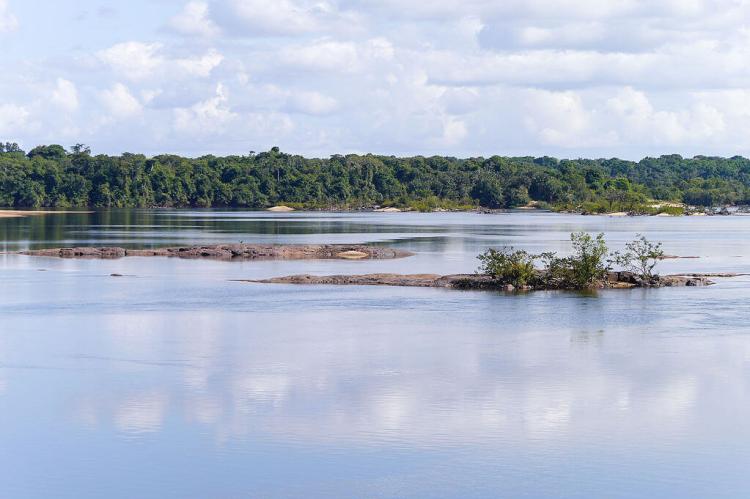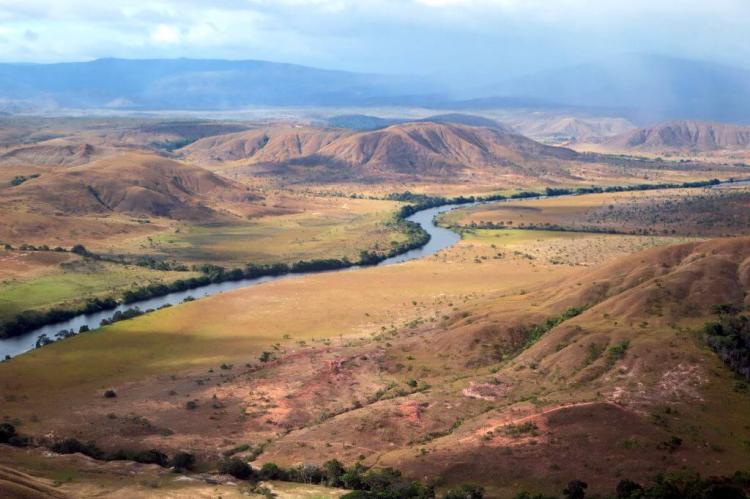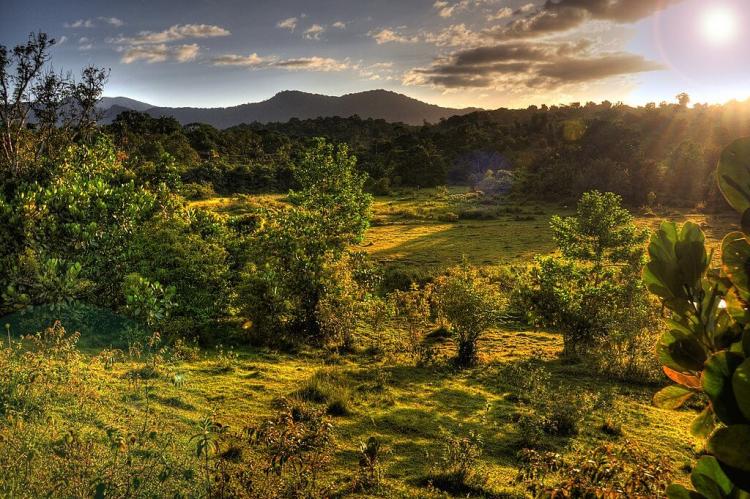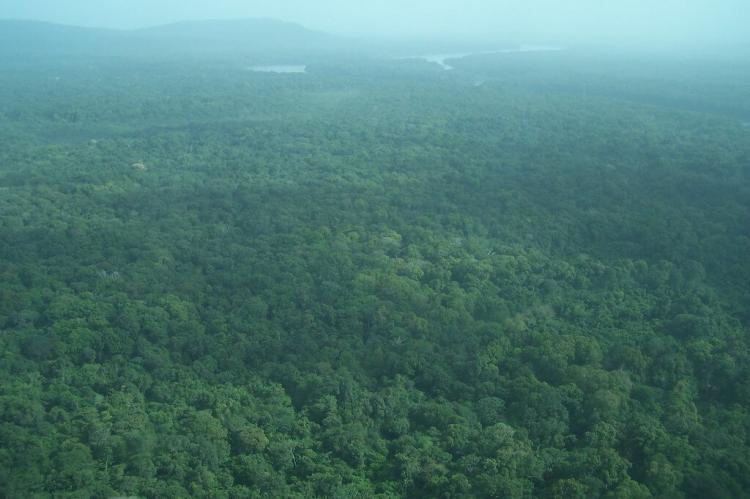Guyana: Natural Landscape
Guyana is located in northeastern South America with an Atlantic coastline, much of which is below sea level at high tide. Sometimes classified as part of the Caribbean region, Guyana can be divided into geographic zones, including a coastal plain, a white sand belt, and interior highlands.
The Natural Landscape of Guyana
Nestled in northeastern South America, Guyana, formerly known as British Guiana, occupies a strategically crucial position, boasting a captivating coastline stretching approximately 459 kilometers (285 miles) along the vast expanse of the Atlantic Ocean. The nation shares its borders with Suriname to the east, Venezuela to the west, and Brazil to the west and south. Despite being the third-smallest country on the South American continent, Guyana encompasses a remarkable land area of 214,970 square kilometers (83,000 square miles), making it a land of immense diversity and natural beauty.
A significant geographical context is Guyana's association with "The Guianas," a regional grouping that includes Suriname (formerly Dutch Guiana) and French Guiana. This connection underscores the shared historical and cultural ties among these neighboring territories, emphasizing a legacy shaped by colonial influences. The three Guianas share a rich tapestry of indigenous heritage, diverse ecosystems, and a unique blend of cultural influences that set them apart from other regions in South America.
Guyana is notably classified within the Caribbean South America subregion, aligning it with neighboring nations and territories along the Caribbean Sea, such as Colombia, Venezuela, Suriname, and French Guiana. This regional affiliation emphasizes the diverse influences and interconnectedness that shape Guyana's geopolitical landscape. The country participates in various regional organizations, including the Caribbean Community (CARICOM) and the Union of South American Nations (UNASUR), fostering cooperation and collaboration on issues of mutual interest.
Guyana's strategic location, coupled with its rich natural resources, including vast tracts of rainforest, abundant mineral deposits, and fertile agricultural lands, positions it as a potential economic powerhouse in the region. With recent discoveries of substantial oil reserves, Guyana is poised for significant economic growth in the coming years.
Biodiversity
Guyana is a global treasure trove of pristine and diverse ecosystems, flourishing under the influence of a tropical climate, varied landscapes, and a relatively low population density.
At the core of Guyana's remarkable biodiversity are its expansive rainforests, predominantly nestled within the interior regions. These luxuriant rainforests, integral to the Guiana Shield—an ancient geological formation—harbor an astonishing diversity of plant and animal species.
Highlighted by the Global Biodiversity Index, Guyana claims the 37th spot worldwide regarding biodiversity. The nation's natural canvas provides a sanctuary for an impressive array of species, including approximately 793 bird species, 135 amphibian species, 996 fish species, 236 mammal species, 175 reptile species, and an astounding 6,500 vascular plant species. This biodiverse haven underscores Guyana's pivotal role in global conservation efforts.
Conservation
Guyana has implemented an extensive network of protected areas to safeguard its diverse ecosystems, encompassing national parks, wildlife reserves, and community-owned conservation areas.
Prominent among these conservation initiatives are:
-
Kaieteur National Park: Encompassing the breathtaking Kaieteur Falls, this park is a guardian of the pristine rainforest, preserving unique flora and fauna.
-
Iwokrama Forest Reserve: Nestled in the heart of Guyana's rainforest, this reserve is dedicated to sustainable forest management, research, and wildlife conservation, contributing to the nation's commitment to ecological sustainability.
-
Kanuku Mountains: In southern Guyana, this protected area harbors critical habitats crucial for biodiversity and provides a sanctuary for various endangered species, playing a pivotal role in the nation's conservation efforts.
While Guyana's commitment to conservation is evident, the nation faces formidable challenges. These include deforestation spurred by logging and mining activities, infrastructure development, illegal wildlife trade, and the impacts of climate change, such as rising sea levels and altering rainfall patterns. Tackling these challenges is integral to sustaining the rich ecological heritage these protected areas aim to preserve.
Climate
Guyana experiences a consistent tropical climate, featuring warm temperatures and elevated humidity levels throughout the year. The average temperature hovers around 27°C (81°F) and an average humidity of 85%. Notably, coastal areas exhibit minimal seasonal temperature fluctuations, providing a relatively stable climate.
Rainfall patterns contribute to the climatic diversity, with the north receiving the highest precipitation and the south and interior regions experiencing comparatively lighter rainfall. The two discernible seasons in Guyana, the wet and dry seasons, delineate the annual weather cycle. The wet season, spanning from December to July, is characterized by substantial rainfall, averaging over 3,000 mm (118 in). In contrast, the dry season spans from August to November, featuring reduced rainfall and lower humidity levels. Even during the dry season, however, Guyana still encounters some precipitation.
Regional nuances further contribute to the climate's variability. Coastal areas tend to be warmer and more humid, while interior regions boast slightly cooler temperatures. The mountainous terrain in the southern part of the country introduces additional climatic distinctions, characterized by cooler and less humid conditions. This nuanced climate profile underscores the geographical diversity that defines Guyana's weather patterns.
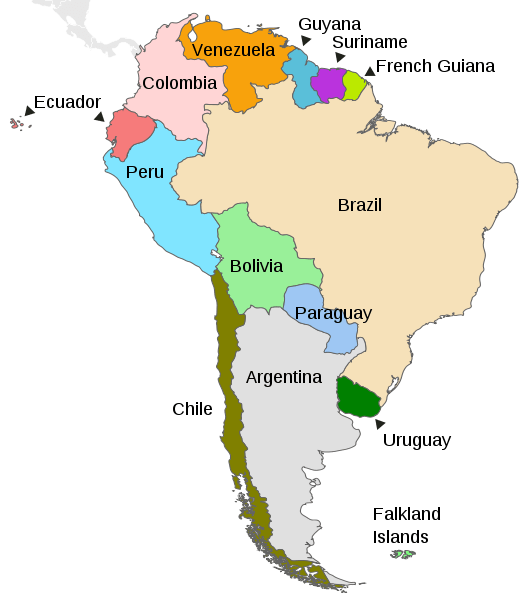
Map depicting the countries on the continent of South America
Natural Geography of Guyana
Geographic Zones
Three primary regions or zones characterize Guyana's geographical landscape:
-
Coastal Plain: A narrow expanse along the Atlantic coast, this fertile marshy plain is densely populated and serves as a vital center for human activity and development.
-
White Sand Belt: Extending inland, this region features a hilly terrain with white sand and clay, housing most of Guyana's valuable mineral deposits. It plays a crucial role in the nation's economic and resource infrastructure.
-
Interior Highlands: Encompassing the remaining expanses of the country, the interior highlands consist of diverse landscapes, including dense rainforests, grassy flat savannas in the south, and elevated mountainous terrain extending towards the Brazilian border. This region adds to Guyana's geographical richness, showcasing a variety of ecosystems and elevations.
Coastal Plain
The coastal plain of Guyana stretches along the Atlantic Ocean, with an average width of 5-6 kilometers (3-4 miles) and a maximum width of 16 kilometers (10 miles). This narrow expanse, encompassing more than 90% of the country's population, plays a pivotal role in Guyana's socio-economic landscape.
To safeguard settlements, including the capital city of Georgetown, a 450-kilometer (280-mile) seawall spans most of the coastline, crucial for mitigating the impact of areas below sea level during high tide. Ongoing efforts, dating back to the 18th century, involve the construction of canals and dikes to manage flooding in this low-lying region.
Comprising alluvial mud carried to the sea by the Amazon River in the south and transported northward by ocean currents, the coastal plain is a product of constant geological activity. This mud layer overlays white sands and clays eroded from the interior bedrock by Guyana's rivers.
Unlike typical shorelines, Guyana's coast lacks well-defined beaches. Seaward from the vegetation line, the landscape transforms into mud flats, shallow waters, and sandbars. These shallow waters pose challenges to shipping, often necessitating cargo unloading before vessels can reach the docks in Georgetown and New Amsterdam. The complex interplay of geological forces and human interventions defines the unique character of Guyana's coastal plain.
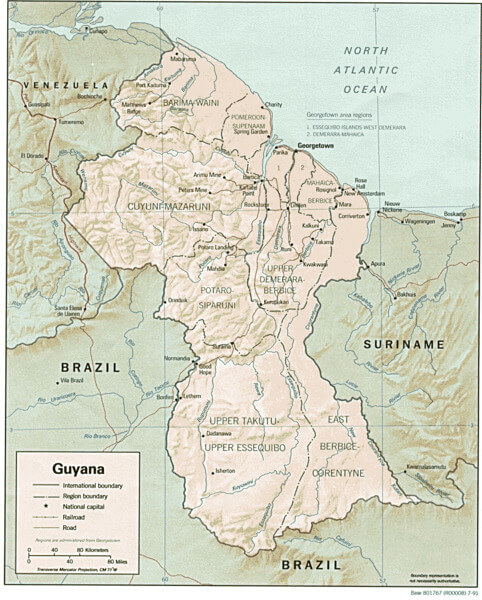
Guyana shaded relief map.
White Sand Belt
The White Sand Belt positioned inland from the coastal plain, unfolds as a landscape characterized by low sandy hills punctuated with rocky outcroppings. A chain of swamps acts as a natural boundary between these interior hills and the coastal plain. The undulating terrain of this region gradually ascends from an average height of 15 meters (50 feet) in the east, nearest the coast, to 120 meters (400 feet) in the west.
Cloaked in a dense hardwood forest, the White Sand Belt is a critical ecological asset. Despite its unsuitability for agriculture due to its sandy composition, the forest is crucial in preventing rapid and severe erosion. Notably, this region houses significant reserves of Guyana's bauxite, gold, and diamond resources.
A small savanna region emerges toward the east, approximately 100 kilometers (60 miles) from the coast, encircled by a low plateau partially overlaid by the White Sand Belt. The plateau, forming the country's central expanse, is marked by igneous rock intrusions, contributing to numerous rapids along Guyana's rivers. This intricate geological interplay defines the White Sand Belt region's unique character and resource-rich nature.
Interior Highlands
The largest among Guyana's geographical regions, the interior highlands unfold a landscape characterized by plateaus, flat-topped mountains, and expansive savannahs extending from the white sand belt to the nation's southern borders. Dominating this region is a vast expanse of grassland, with the Rupununi Savannah in southern Guyana serving as its most significant manifestation, stretching into the territories of Venezuela and Brazil.
The western sector of the interior highlands is marked by the imposing Pacaraima Mountains (or Pakaraima Mountains), notably featuring Mount Roraima, situated at the tripoint border of Brazil, Guyana, and Venezuela. To the south, the Kaieteurian Plateau unfolds, adorned with the majestic Kaieteur Falls, alongside the formidable Kanuku Mountains. Further south, the Acarai Mountains line the border with Brazil.
Among Guyana's loftiest peaks, notable summits include:
- Mount Ayanganna: 2,042 meters (6,699 feet)
- Monte Caburaí: 1,465 meters (4,806 feet)
- Mount Roraima: 2,772 meters (9,094 feet)
This expansive and diverse interior highlands region showcases Guyana's topographical richness, featuring a stunning array of geological formations and elevations.
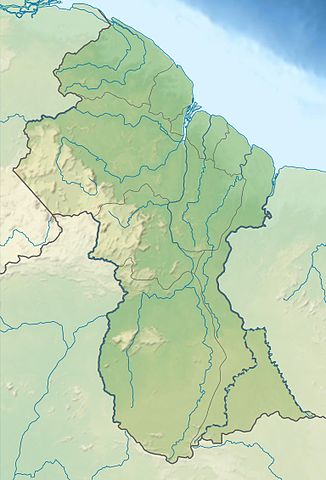
Relief map of Guyana
Islands
There are many islands in Guyana, most of which are in the Essequibo River, the country's longest. The river has over 365 islands. Some of the notable islands of Guayana include:
-
Hogg Island: Hogg Island is the largest island in Guyana and is not part of the Essequibo River system. It is located in the Atlantic Ocean, about 30 km (19 mi) off the coast of Guyana. The island is home to about 1,000 people.
-
Fort Island: Fort Island is located in the Demerara River, about 10 km (6 mi) from Georgetown. The island is home to a fort that was built in the 1700s.
-
Wakenaam Island: Wakenaam Island is the largest island in the Essequibo River. It is 100 km (62 mi) long and 30 km (19 mi) wide. The island is home to about 2,000 people.
-
Leguan Island: Leguan Island is the second-largest island in the Essequibo River. It is 70 km (43 mi) long and 20 km (12 mi) wide. The island is home to about 1,000 people.
-
Bartica Island: Bartica Island is located at the mouth of the Essequibo River. It is 5 km (3 mi) long and 2 km (1.2 mi) wide. The island is home to about 5,000 people.
-
Trinidad Island: Trinidad Island is located in the Essequibo River, about 50 km (31 mi) downstream from Bartica. The island is home to about 100 people.
-
Apai Island: Apai Island is located in the Essequibo River, about 100 km (62 mi) downstream from Wakenaam Island. The island is home to about 50 people.
-
Kaituma Island: Kaituma Island is located in the Essequibo River, about 150 km (93 mi) downstream from Wakenaam Island. The island is home to about 20 people.
-
Waini Island: Waini Island is located in the Essequibo River, about 200 km (124 mi) downstream from Wakenaam Island. The island is home to about ten people.
Bodies of Water
Guyana is home to a diverse range of bodies of water that play a crucial role in shaping its landscape, ecosystems, and economy. From large rivers and extensive estuaries to coastal lagoons and offshore zones, Guyana's bodies of water provide a wealth of natural resources, support a wide array of wildlife, and offer numerous opportunities for recreation and livelihoods.
See more: Water Bodies of Guyana
Administrative Divisions
Guyana has been divided administratively into ten regions and 27 neighborhood councils.
See more: Cultural Landscape of Guyana
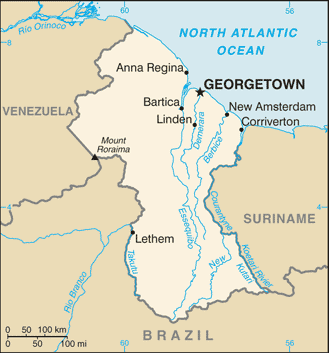
CIA map of Guyana
Natural Regions
Guyana's diverse landscape can be classified into four distinct natural regions:
-
Low Coastal Plain: Most of the population resides in this narrow, fertile, marshy plain along the Atlantic coast. It serves as a vital hub for human settlement and economic activities.
-
Hilly Sand and Clay Region (White Sand Belt): This region houses Guyana's principal mineral deposits further inland. Characterized by undulating terrain, it plays a significant role in the nation's mineral resource infrastructure.
-
Forested Highland Region: Nestled in the heart of the country, dense rainforests define this region. Serving as a critical component of Guyana's biodiversity, these lush forests contribute to the nation's ecological richness.
-
Interior Savanna: Encompassing the grassy flat savanna in the south and the extensive interior highlands, this region is predominantly marked by mountains gradually ascending toward the Brazilian border. The interior savanna showcases a captivating blend of grasslands and elevated terrains, adding to the geographical diversity of Guyana.
Ecological Regions
The following is a list of terrestrial ecoregions in Guyana, as defined by the World Wide Fund for Nature (WWF). Guyana is in the Neotropical realm. Ecoregions are classified by biome type - the major global plant communities determined by rainfall and climate.
Tropical and subtropical moist broadleaf forests
Tropical and subtropical grasslands, savannas and shrublands
Mangroves
-
Guianan mangroves
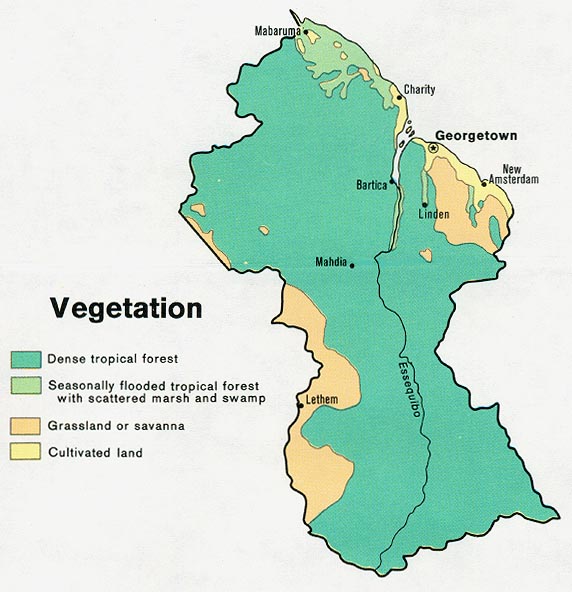
Vegetation map of Guyana
